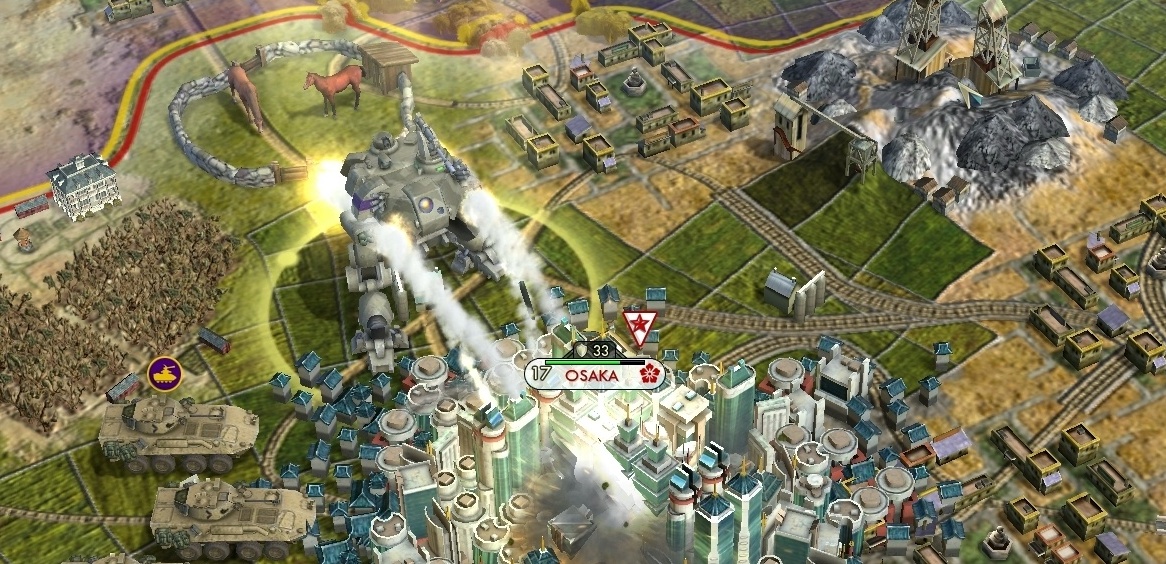Our Verdict
Gorgeous graphics and deep combat make this a great place to start or renew your interest in global domination.
PC Gamer's got your back
Defying the urge to phone-in an unambitious sequel and coast on past successes, Sid Meier's Civilization V is anything but a lazy rehash. It feels almost as if someone described the concept of the renowned 19-year-old turn-based strategy series to a talented designer who'd never played it, and let him come up with his own version. It's similar enough to be familiar to veterans, different enough to be fresh, and its polish and accessibility make it a great place for new players to pick up one hell of a Civ addiction.
At a foundational level, it's very familiar. You begin with a single settler in 4000 BC, and over the next 6,050 years you lead your fledgling nation turn-by-turn as you found a city, research technologies, raise an army, build history's greatest man-made wonders, expand to a sprawling empire and finally make your play for world domination - all in competition with other nations.
Graphics may be superficial in a game like this, but it has to be said that Civ V is indisputably the best looking turn-based strategy game ever made. The painterly art style of the randomly-generated virgin landscape you see when starting a new game feels like Monet meets Google Maps, with bright colors and stunning attention to detail. Zooming in on a tile with a fur resource shows a pair of foxes frolicking together. Cattle, sheep, horses and elephants graze their respective tiles indicating sources of food, mounts and ivory, and in the hypnotically glistening ocean you can see whales breaching and schools of fish swimming beneath the surface. It's the most beautiful, lively virtual game board you've ever seen.
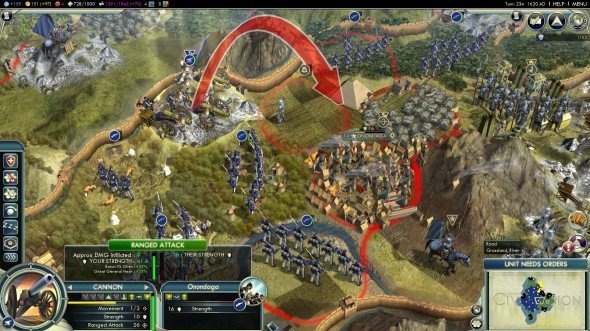
Things are equally impressive when humans arrive and start paving over the natural beauty. There are several distinct styles to cities from different cultures (Asian, European, African, etc.) and not only do the bonus-giving Great Wonders, like the Pyramids or the Statue of Liberty, appear on the map, you can actually see them under construction . After staring almost unblinkingly at these images for dozens of hours, I really appreciated the craftsmanship here.
Under the striking visual layer are innumerable changes to the usual Civ gameplay. Some seem like a bigger deal than they actually are—going in, I'd expected the most dramatic one would be the shift from the traditional map of a grid of squares to Civ V 's honeycomb of hexagons. In practice, this turned out to be one of the least transformative changes—after just a few minutes of ordering around my units I barely noticed the difference, and I never once found myself pining for the old squares. Likewise, though I wasn't certain about it for the first dozen hours or so, the new super-friendly interface has grown on me quite a bit, despite its almost over-eagerness to move things along.
This is war
In reality, the most revolutionary renovation is warfare. When nations collide, this is far and away the most tactically deep Civ ever. In board game terms, Civ I through IV are like Risk, where you can stack all your armies on one space and march around the world conquering everything in your path. Civ V scraps that system in favor of something more like global-scale chess, where each space can only be occupied by one combat unit at a time, and some, like archers and artillery, can attack over a distance.
This changes absolutely everything about the way war is fought, and almost entirely for the better. Unit positioning matters almost as much as having the most technologically advanced military—and it's far more than just placing your spearman on a defensible hill or forest tile. You've also got to take into account if you're attacking across a river, flanking bonuses (putting two of your units adjacent to an enemy unit), any bombardment units or aircraft in range and the huge impact of the presence of a Great General. Plus, cities are now formidable combat units themselves with built-in defenses, and never give up without a fight.
It took a bit of practice to learn how to plan my troop movements to avoid slapstick-comedy traffic jams and bottlenecks, but once I got the hang of it I found it to be extremely nuanced. I had to pause and consider how to approach an enemy city, since charging in unprepared risks annihilation by an inferior but better-prepared opponent.
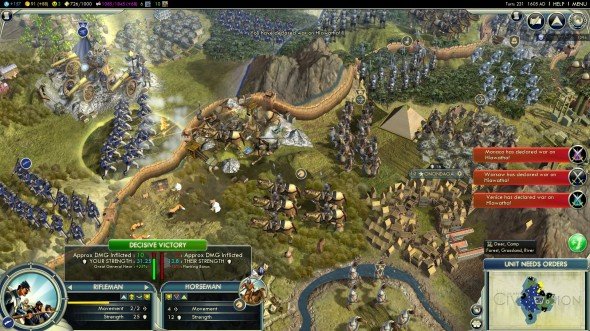
Combat is so engrossing that my first few games were all about conquest, even though I initially set out to win by being the first nation to research, build and launch a spaceship to another solar system. I couldn't resist going on rampages, wiping out other nations in 'self defense'. Oh, so I took St. Petersburg and now you want to negotiate peace, huh? Well too freaking bad! You shoulda thought of that before you decided to take a shot at me, Catherine the Great.
This is a huge step forward for Civ warfare, but it isn't perfect. Having to move each unit individually rather than in stacked groups makes moving a large force around pretty tedious. A bigger problem is the AI, which can't grasp the subtleties—it has a bad habit of wheeling its long-range artillery directly up to my melee units. On higher difficulty levels the AI simply gets a resource boost to overwhelm you with numbers, rather than any more tactical smarts.
When AI attacks
That's not to say it's easy to tackle—at this point any difficulty level higher than the “normal” Prince level beats me up and takes my national lunch money —but some victories felt undeserved.
Playing against human players solves that problem, and Civ V 's slew of flexible options let you scale a standard game's marathon length down to a more manageable couple of hours. Sadly, the battles don't work quite as well in the confusing, simultaneous turn-based multiplayer, where all players are all moving their pieces in no particular sequence at the same time. It's messy and unpredictable, especially coming from the orderly turn-taking of single-player. It's still fun, just … uncivilized.
In some ways, though, the AI impressed me. Leaders are perceptive enough to pop up and inform me that they're not going to stand for my massing armies on their borders. That said, diplomacy could stand to be a little more transparent—sudden declarations of war caught me totally off guard, like when, after a long period of peace and mutually beneficial trade relations with Gandhi's India, the little bald jerk allied with Japan to invade my Roman Empire without provocation. Think about that for a second: I was attacked by Gandhi. It's hard not to take that personally.
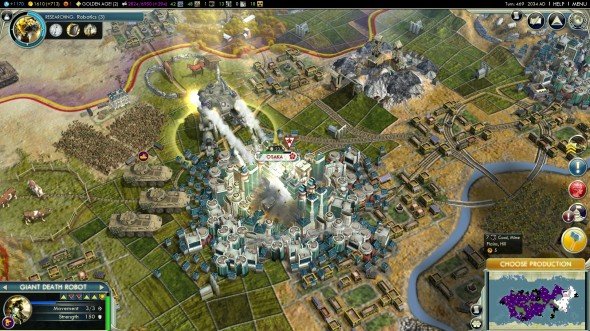
While combat has become more complex and more demanding of your attention, other areas have been mercifully simplified to prevent mental overload. You couldn't ask for better city automation tools—if you want, you never have to do anything besides pick what you want your cities to build. In a big divergence from past Civ s, the populations of cities don't have individual moods, but all contribute to a national happiness level that can boost you into a super-productive golden age or drag you down into stagnation. It's a simple concept to grasp, and it requires far less micromanagement because you're able to build a lot of happiness-producing structures in successful cities that balance out discontent elsewhere.
Policy upgrades
Likewise, the new government system does its best to avoid over-complicating itself. It's essentially a set of 10 RPG-style skill trees that allow you to shape your government over time, rather than make an abrupt shift from a republic to communism.
When you've built up some culture points, you unlock policy categories one at a time, then spend points within those categories to unlock specialized bonuses that boost your economy, army, research or other trait. It didn't require me to cripple myself to experiment—some choices are better than others for certain situations, but they're all useful, and timely policy unlocks saved my bacon more than once. When I nearly drove my empire into financial ruin with military unit upkeep costs, I unlocked the base level of the Autocracy tree. Instantly my unit maintenance cost was reduced by a third, balancing the budget and netting me a nice surplus. However, in doing so, I closed off the Liberty and Freedom trees and their bonuses to population growth and culture generation. Still, sacrifices must be made in war.
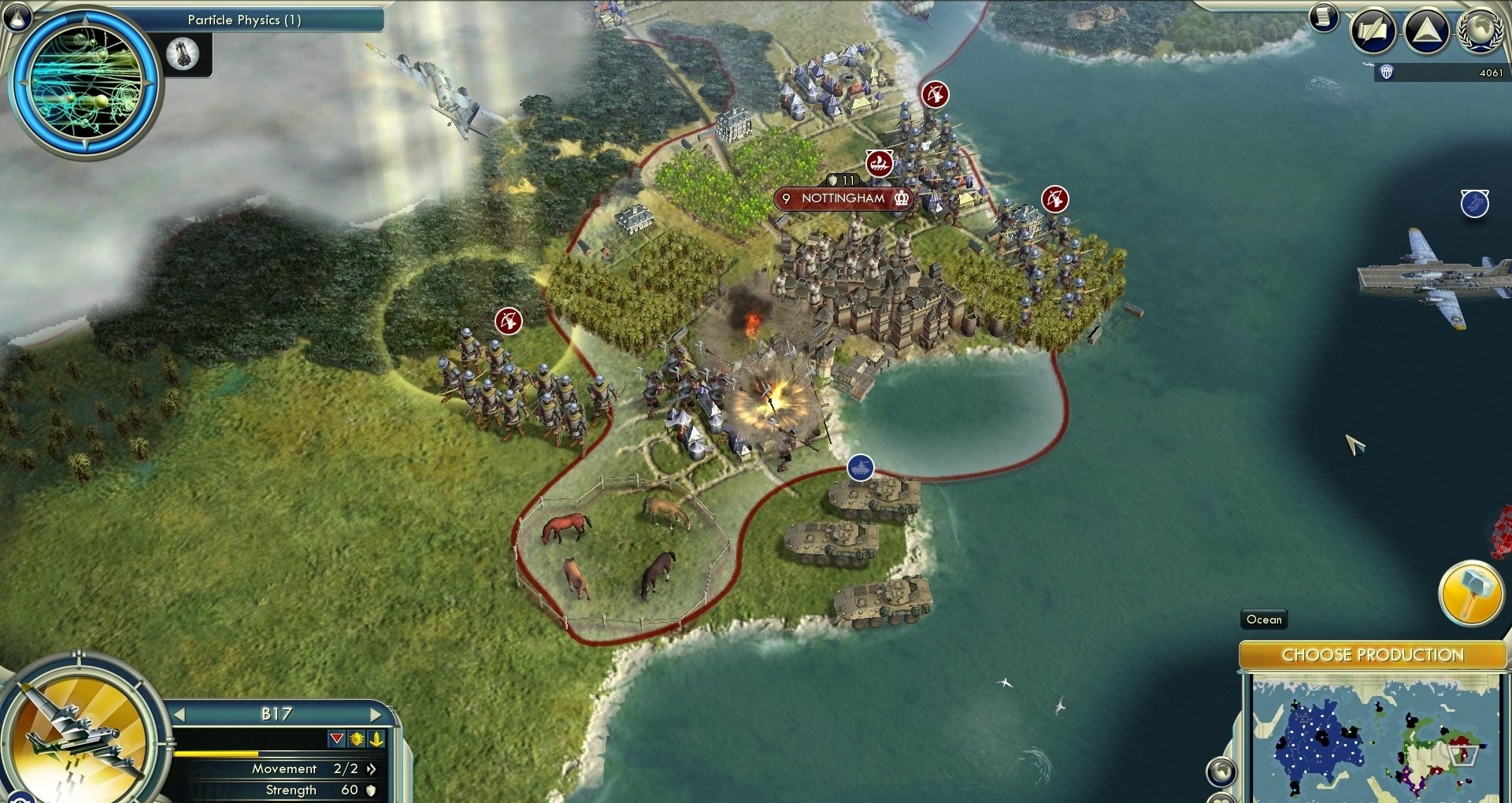
One other area has seen a rise in complexity: I'm a big fan of the way that Civ V treats strategic resources like horses, coal and uranium. If I only have one horse available, I can only build one mounted unit. It makes such resources feel much more valuable and worth trading and fighting for. Technology is also precious: unlike previous Civ s , in this one you can't swap technologies with your allies for quick advancement. I had to look at resource management in a whole new way: if I didn't research it, I didn't get it. It makes catching up from a tech deficit significantly more difficult, too, so I felt particularly motivated to prioritise meeting the efforts of my nation's needs.
Along with bands of roving hostile barbarians, Civ V 's maps come pre-populated with city-states, single-city civilizations which are basically Civ 's equivalent of quest-giving NPCs. Keep them happy and safe, and they'll reward you with alliances, trade goods, culture points and even free military units.
They may not have the personality or megalomaniacal ambition of full-fledged nations, but they're an entertaining addition—especially when they put hits out on their neighboring city-states. It's a little disappointing that pretty much the only way to reliably keep them on side for long is to pay for their friendship, but when you tire of their insolence you can just conquer them like any other city.
Conquer and rule
What to do with a city when you conquer it? Civ V gave me an interesting new option alongside annexing your prize directly and burning it to the ground: installing a puppet ruler who would run the city as an independent subsidiary of your empire, kicking up all the profits generated but not allowing you to dictate what it builds. As a mostly conquest-oriented player more interested in warfare than hands-on governing, I found this option invaluable, since it averted the nation-wide buzzkill that accompanies an occupied populace and staves off the end-game doldrums of past Civ s, in which turns took forever because you had to do everything yourself.
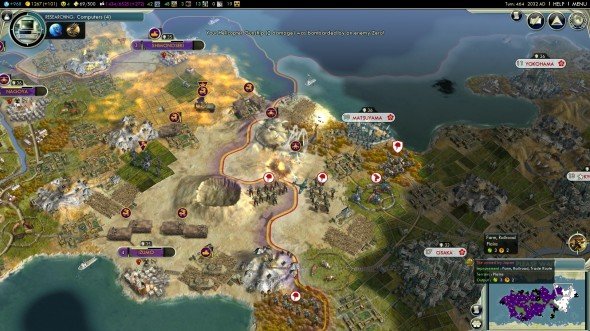
I'm going to be playing Civ V for a very, very long time. The freedom to pursue multiple victories—domination, scientific, cultural, diplomatic or simply running out the calendar with the highest score—combined with the wide range of interesting faction bonuses and unique units makes it almost endlessly replayable. (You may have heard that Civ V will have launch-day DLC for sale, peddling an extra Babylonian faction, but take my word for it: the 18 off-the-shelf factions are plenty.)
As for where this game fits into the series, Civilization V isn't necessarily a definitively 'better' empire-building game on Civilization IV – as that would be almost impossible. This is more of an equal that exists in parallel, offering a fresh and invigorating style of play with more emphasis on combat.
Civ V isn't simply a rehash of what came before with better graphics (though it has those, too): it's a whole new world with a whole new set of rich, intricate rules to master. It's also impossible for a strategy fan to resist picking up … or to quit.
Gorgeous graphics and deep combat make this a great place to start or renew your interest in global domination.
